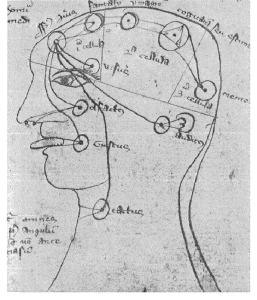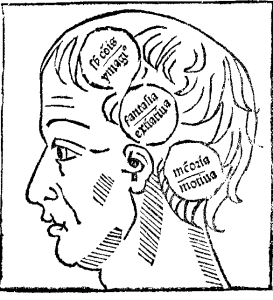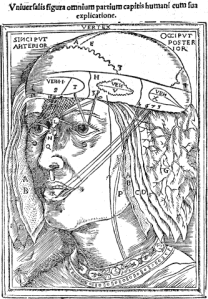Roads to everywhere
The image below was painted over 20 years ago by Rachel Napaljarri Jurra, an Australian aboriginal woman , as part of a successful programme to educate young aboriginal people about the dangers of solvent sniffing. This particular image with roads to everywhere is how she thought the brain worked. Subsequent images showed a progressive brain destruction via solvents. I marvel at this image, and every time I look at it I see something new. It is truly a neuromatrix as we now conceptualise it – a representation of dynamic distributed processing. And it was painted well before brain imaging was in the popular media. It makes me think – what do we really know, what is really new?
On the medieval cell doctrine
I have just read Harry Whitaker’s 2007 essay ‘Was medieval cell doctrine more modern than we thought?’ – an interesting read. Medieval cell doctrine is traditionally the view that cognitions and memories are held in the easily observable, fluid filled ventricles. The view held up well into the 17th century despite no evidence that the ventricles connected to any pathways. However, a cortical localisation variant (i.e. a form of neuromatrix conceptualisation) has been shown to date back to the 12th century. And not only does Whitaker present evidence of cortical localisation, there is also evidence of the existence of medieval concepts of dynamic processing.
The image above was drawn in 1503 by anatomist in Bologna. This and similar images have lead modern scholars to assume our medieval colleagues were still all about ventricles, but what was missed was that the latin word ventriculus also means lobe. The three circles are for brain areas representing sensory input and imagination, fantasy and estimation above the ear and memory and motion at the back of the head.
You can see this expanded in this next image (above) by Eichmann in 1537, popularly known as Dryander. See how the sensory input goes to the first and second cells and note the nice motor control of speech from the third cell.

This final image (above) is drawn by Avicenna, a famous Arab physician in the mid 14th century. Although somewhat linear, the dual lines represent back and forward flow. There are cells for fantasy, cognition, imagination and memory plus the five senses. But there is clearly linkage of cognitions and the senses in brain matter.
Sticking with the neuromatrix
Our medieval colleagues may have been much more up with concepts of distributed processing than we thought. These days there are some challenges to the neuromatrix as a broad and guiding paradigm for brain engagement. But for now I am going with what could be tens of thousands of years of aboriginal observation and at least 700 years of European and Arabic conceptualisation.
– David Butler
THE 2017 NOI CALENDAR IS SHAPING UP, HERE ARE THE CONFIRMED DATES FOR NOW
Melbourne 31 March – 2 April EP and GMI
Darwin 4 – 6 August EP and GMI
Brisbane 25 – 27 August EP and GMI
Don’t worry SA and NSW, we’re very close to confirming dates and locations to bring you some love too.
Check out our courses page for details and to enquire
HAVE YOU DOWNLOADED OUR NEW PROTECTOMETER APP YET?

Just search the App Store from your iPad for ‘Protectometer’
WE’RE PACKING UP EP3 AND TAKING IT ON THE ROAD IN THE USA

EP3 events have sold out three years running in Australia, and we are super excited to be bringing this unique format to the United States in December 2016 with Lorimer Moseley, Mark Jensen, David Butler, and a few NOI surprises.
EP3 EAST Philadelphia, December 2-4 (nearly full, last tickets going fast)
EP3 WEST Seattle, December 9-11 (nearly full, last tickets going fast)
To register your interest, contact NOI USA:
p (610) 664-4465
e noius@noigroup.com




Hey Dave, great pics, but maybe like the neuromatrix itself these may have historical value only 🤔. Embodied Predictive Processing is where it’s at… 😜
Looking at those three old diagrams, I couldn’t help but notice that the *person* is still there (quite literally) – that the brains are embodied, not just floating in the ether as they so often appear in modern images. Perhaps we can learn something then – as we move on from industrial and computer metaphors for brain and mind, maybe we can put brains back inside people!
Really hoping that there is some good debate on this one, and if anyone can tell me what a ‘sentient neural hub’ is, and how it “transduces the flow of neurosignatures into the flow of awareness” I’ll be very grateful! (Reckon old Ron got a free pass on that one.)
Tim
Fascinating David……”brains inside people” nice one Tim 👍
I agree, the top image is a very compelling representation of a brain neuromatrix!
For Tim, and from memory, a potential ‘sentient neural hub’ is the insula cortex (homeostatic sensory input and integration posteriorly to middle insula with meta-representation as awareness anteriorly), with the autonomic motor arm in the anterior cingulate cortex, according to Bud Craig.
I am interested in how well accepted Bud Craig’s work is among the neuroscience community presently?
Max
Hey Max
Thanks for dropping by.
I must confess that my question was mostly rhetorical – I think Melzack got a free pass on the whole idea of the SNH – neatly sidestepping thousands of years of thought and argument about minds, bodies and brains. Even if the ‘easy problem’ of just how the SNH transduce neurotags into the flow of awareness were to be solved, the ‘hard problem’ of why this particular bit of transducing gives rise to ‘something it is like’ to experience pain, or be conscious, still obtains. I’m partial to the notion that brains are necessary, but not sufficient for consciousness/subjective experience, so I don’t think that any one subregion of the brain will explain the whole kit and kaboodle!
A couple of fairly recent observation studies might knock the insula out of contention as the seat for sentience –
Damasio, A., Damasio, H., & Tranel, D. (2013). Persistance of feelings and sentience after bilateral damage of the insula. Cerebral Cortex, 23(4), 833-846
Feinstein, J. S., Khalsa, S. S., Salomons, T. V., Prkachin, K. M., Frey-Law, L. A., Lee, J. E., Tranel, D., & Rudrauf, D. (2015). Preserved emotional awareness of pain in a patient with extensive bilateral damage to the insula, anterior cingulate, and amygdala. Brain Structure and Function. doi: 10.1007/s00429-014-0986-3.
I take it that Craig’s work has been highly influential, but the criticisms that I’ve read of his work mainly focus on its line-labelled nature. However his work has informed some very interesting Predictive Processing theories of interoception, such as the work from Anil Seth (see, for eg – http://www.sciencedirect.com/science/article/pii/S1364661313002118 ).
Thanks again
Tim
Hey Tim – what’s with the historical neuromatrix!!
Where are we at? As far as people suffering and the clinicians treating them are concerned, embodied predictive processing is something that still exists in the most rarified atmosphere.
Sixty percent of Explain Pain course participants, prior to the course, agree with the statement “there are special pain receptors and pain messages that travel up to the brain” (Q1 in the quiz). And this is a ‘with it’ group. I suspect that the number of clinicians who believe this false statement could be as high as 80%.
So in thinking where we are at – it’s nowhere near the brain. Many medicos think gate control theory is where we are at. We are nowhere near the basics of distributed processing, beautifully delivered to us by age old neuromatrix concepts, and fundamental to embodied predictive processing! Sadly, the majority of those at the clinical battlefront would consider EPP as an esoteric wank. Might get worse if we end up with an anti-science president in the US!.
Cheers all
David
Thanks for clarifying Tim, but also to NOI for providing a platform that allows clinicians like us, battling on a daily basis, to contribute.
I thought all 3 articles you cited were absolutely fascinating, particularly the article by Damasio et al, who have proposed an extension of the SNH to the brainstem as well as placed some emphasis on the role of humoural/paracrine signalling in interoception. I wonder if and to what extent the recently emergent evidence on structure and function of the choroid plexus as an important inflammatory and immune ‘educative gate’ will eventually show to significantly affect interoceptive predictive coding (eg. Demeestere et al 2015)?
Thanks again,
Max
Demeestere D, Libert C, Vandenbroucke R. Therapeutic implications of the choroid plexus-cerebrospinal fluid interface in neuropsychiatric disorders. Brain, Behavior, Immunity. 2015: 50; 1-13.